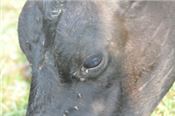Rains + Heat = Fly Control Problems

Figure 1. Weekly counts or estimates (face flies/head or horn flies/side)
can catch fly increase early and allow corrective action.
Photo: Lee Townsend, UK
DR. LEE TOWNSEND
LEXINGTON, KY.
Pasture flies (horn flies and face flies) and confinement flies (stable flies and house flies) need moist breeding materials. Horn flies and face flies develop in fresh cow manure; stable flies and house flies develop in mixtures of manure, decaying hay, and spoiled feed. Quick drying breeding sites can mean that that fewer fly eggs hatch, more maggots dehydrate, and fewer flies make up the next generation. The impact of this environmental control can breakdown if frequent rains keep valuable fly resources productive longer.
High temperatures speed up the development of these pests, chopping several days off the development time from egg to adult. This can lead to an extra generation or two during the fly season and higher fly numbers to stress animals and potentially increase transmission of fly-borne diseases. The weather can be too hot and too dry for flies but above-normal rain can give flies the humidity that they need to cope with the heat. The combination of the two can strain usually effective fly control programs.
Monitoring Fly Numbers
Pasture Flies
Monitor pasture fly numbers on 10 percent of the herd weekly and record numbers. Good goals are to keep face fly numbers below 10 per head and horn flies below 100 per side. You can catch jumps in fly numbers more quickly with this information and then take steps to increase control. Addition of an oiler or forced-use dust bag can be an effective way to supplement pasture fly control.
Stable Flies
Stable flies can be costly pests around dairy and confined beef cattle. These biting flies feed on lower legs and underbellies of animals. Count the numbers of stable flies on the legs of 10 percent of the herd. An average of 5 or fewer of these flies per leg is a good target.
House Flies
High populations of house flies are a nuisance that can lead to complaints from neighbors. More importantly, they can carry some diseases associated with animal and human health. Index cards (3 X 5 inches) make good fly monitoring tools. Cards can be pinned to surfaces where flies rest at night (rafters, joists, hanging lights). Resting flies will leave specks consisting of fecal spots and will regurgitate on these cards. Record the speck counts by card location and watch for increases that indicate a growing population. Count specks on the whole card or use square inch sub-sections as appropriate. Fewer than 100 specks per location per week should indicate an acceptable number of flies. Replace the cards at weekly intervals.
Space sprays of fast acting insecticides, such as pyrethrins, can be used to knock back fly numbers. Increasing numbers frequently mean improvements in sanitation and water management are needed. ∆
DR. LEE TOWNSEND: Extension Entomologist, University of Kentucky